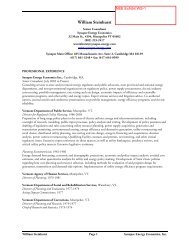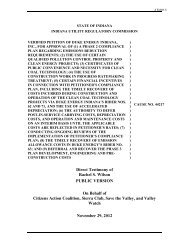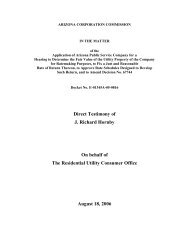Best Practices in Energy Efficiency Program Screening - Synapse ...
Best Practices in Energy Efficiency Program Screening - Synapse ...
Best Practices in Energy Efficiency Program Screening - Synapse ...
Create successful ePaper yourself
Turn your PDF publications into a flip-book with our unique Google optimized e-Paper software.
Figure 4.2. Projected Utility Generation Resources <strong>in</strong> 2015 – Relative Cost and Risk<br />
Source: Ceres 2012, p.9.<br />
Plann<strong>in</strong>g risk. When it turns out electric demand growth is lower than expected, there is<br />
a risk that a portion of the capacity of new power plants may be unused for a long time.<br />
In January 2012, lower-than-expected electricity demand along with unexpectedly low<br />
natural gas prices, led M<strong>in</strong>nesota-based wholesale cooperative Great River <strong>Energy</strong> to<br />
mothball its brand-new coal-fired power plant immediately after the plant’s completion.<br />
The utility expects to pay an estimated $30 million next year just for ma<strong>in</strong>tenance and<br />
debt service for this plant (Ceres 2012, page 33). <strong>Energy</strong> efficiency resources that<br />
reduce load <strong>in</strong>crementally never face this type of problem.<br />
Reliability risk. <strong>Energy</strong> efficiency can improve the overall reliability of the electricity<br />
system. First, efficiency programs can substantially reduce peak demand, dur<strong>in</strong>g those<br />
times when reliability is most at risk. Second, by slow<strong>in</strong>g the rate of growth of electricity<br />
peak and energy demands, energy efficiency can provide utilities and generation<br />
companies more time and flexibility to respond to chang<strong>in</strong>g market conditions, while<br />
moderat<strong>in</strong>g the “boom-and-bust” effect of competitive market forces on generation<br />
supply (RAP 2001). Lastly the operat<strong>in</strong>g risk of a large power plant (i.e., forced outage)<br />
can be catastrophic while the operat<strong>in</strong>g risk of energy efficiency is m<strong>in</strong>imal because a<br />
large power plant could lose the entire energy supply while energy efficiency could lose<br />
only a small portion of its expected energy sav<strong>in</strong>gs.<br />
New regulation risk. Fossil fuel and nuclear power plants have a risk of fac<strong>in</strong>g new<br />
regulation that makes them more costly or uneconomic. For example, the nuclear safety<br />
regulation is likely to become stricter due to the recent accident at Fukushima <strong>in</strong> Japan,<br />
which could <strong>in</strong>crease the operat<strong>in</strong>g or construction cost of nuclear power plants (Ceres<br />
2012). The new and proposed US EPA air regulations have already revealed numerous<br />
coal-fired power plants that are likely to become uneconomic and retire. AEP recently<br />
| 46 <strong>Best</strong> <strong>Practices</strong> <strong>in</strong> <strong>Energy</strong> <strong>Efficiency</strong> <strong>Program</strong> Screen<strong>in</strong>g | www.nhpci.org







